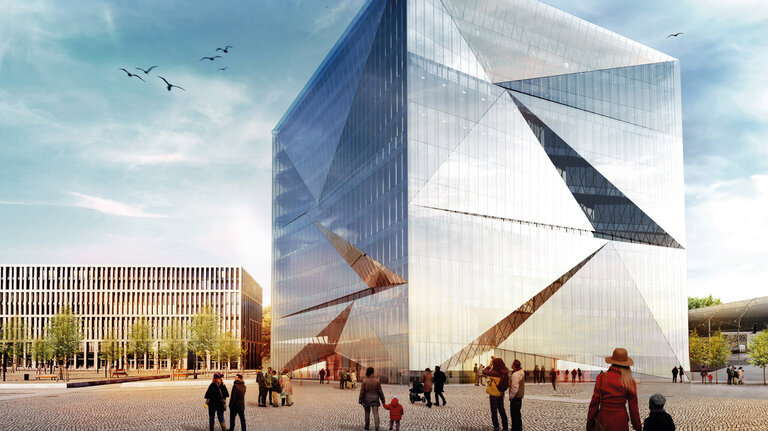What is special about cube berlin is not just its dramatic architectonic shape, but above all that it has artificial intelligence (AI), in other words, a ‘brain’. Following the highest IT security standards, it establishes an intelligent link between all technological equipment and sensors along with planning, operational and user data for optimal control of the processes that take place in the building. The ‘brain’ learns from the data connected with the operation, the users and the environment, and makes suggestions for improvements. For instance, unused spaces in the building will not need heating, ventilation or lighting. The system will recognize this and switch off the equipment in these areas. Tenants in cube berlin can also use the specially developed app to enable them to operate the air conditioning, access controls, parcel booths and much more themselves.
Extensive Tests in the Aachen Demonstration Factory
Two years before the building is due to be completed, CA Immo has already begun to put into operation the hardware and software for the smart commercial building and to conduct extensive tests with support from Drees & Sommer. The tests are being carried out at the Demonstration Factory in the Smart Logistics Cluster at the campus of RWTH Aachen University, now considered the Silicon Valley of Germany. Matthias Schmidt, Head of Development Germany at CA Immo, commented: ‘In Aachen, the interaction between the different hardware and software components used for digitization can be represented in the model before cube berlin is even commissioned, and tested using different criteria. For instance, digitization experts are investigating the compatibility of the products.’ Particular attention is given to the issue of cybersecurity, he added.
Analysis of User Behavior Enables Efficient Operation
Matthias Schmidt explained: ‘The question constantly facing us as portfolio holders is how we can continue to meet tenants’ needs and offer attractive spaces in the future. With digitized buildings such as cube berlin, we are creating added value for tenants. We are providing a management cockpit that gives information on the key data and any changes in it. This includes extensive information on energy consumption, user behavior, and much more. Tenants thus experience not only the user interface of the app, but also the operational level in the background, and they can even intervene, for instance, to optimize the use of the space. The software-based digitization concept is modular in design, so it can be implemented by us at minimal cost in established buildings.’
3,750 Sensors Put Users’ Needs First
Design thinking processes can be used to define the requirements of users of a smart commercial building. Klaus Dederichs, Head of ICT and Associate Partner at Drees & Sommer SE, explained: ‘The smart commercial building is a new type of property. Users and their needs are at the forefront of the development process. The digital conceptual design process is modelled on people. While the sensors represent the sensory organs, the AI-enabled system platform of cube berlin is the ‘brain’. We have selected around 3,750 suitable sensors on this basis.’ Smart, digital technologies are put together in different combinations depending on the particular building or project, and they make it easier for users to operate the building. They offer possible new uses such as indoor navigation, tracking of people and objects, and access control using facial recognition.
Users of cube berlin will be helped by a special building app created by Thing Technologies, which only uses personal data to the extent permitted by the European Union General Data Protection Regulation (GDPR). Klaus Berberich, co-founder of the proptech company Thing Technologies, with headquarters in Frankfurt am Main, commented: ‘To maximize acceptance, the app is entirely aimed at creating added value for the user, and offers everyone a wide range of options and simplifications. The fact that the individual users decide for themselves how they are going to use the app provides additional motivation for us.’
The Working Environment of the Future in a Smart Glass Cube
The eye-catching building was designed by 3XN Architects in Copenhagen. With a gross floor area of 19,000 square meters, the eleven-story commercial building offers users flexible interior design concepts for future-proof working environments in areas of between 300 and 1,400 square meters per floor.
